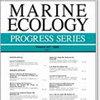蟛蜞菊对南部非洲盐沼中脐带草生长的自上而下的比例效应
IF 2.1
3区 环境科学与生态学
Q2 ECOLOGY
引用次数: 0
摘要
摘要:盐沼的生产力历来被认为主要由自下而上的过程驱动,但最近在北美、欧洲、亚洲和南美洲进行的研究表明,食草动物自上而下的作用力也会影响沼泽植被的结构。迄今为止,这种放牧压力的普遍性尚未在非洲盐沼中得到验证。在这里,我们研究了南非河口沼泽中的优势螃蟹是否会吃活体植物,以及这种相互作用是否会对基础物种 Spartina maritima 产生直接影响。我们采用了自然调查、实验室喂食试验、饮食分析和野外实验等方法。虽然我们在调查中没有发现螃蟹与沼泽植物结构之间有明显的关系,但肠道内容物和稳定同位素分析表明,S. maritima存在于螃蟹的食物中,但并不突出。所有 S. maritima 成分都被吃掉了。与对照组相比,在野外操纵螃蟹密度和大小结构(不包括 5 毫米的螃蟹)对 S. maritima 茎干密度和地上生物量的影响较小。综合来看,这项研究表明,南非沼泽中的螃蟹确实吃活的灯心草,而且它们的影响似乎取决于密度。沼泽植物受到的自上而下的影响无法通过自然密度相关性检测出来,这可能是由于收集数据的尺度与野外实验不同。这些结果证明,全球范围内普遍存在放牧活体沼泽基础植物的现象。未来对这些系统的研究应通过添加实验或排除捕食者来控制螃蟹密度,以了解高密度螃蟹的影响以及是什么力量在调节它们的种群。本文章由计算机程序翻译,如有差异,请以英文原文为准。
Proportional top-down effects of grapsoid crabs on growth of Spartina maritima cordgrass in southern African salt marshes
ABSTRACT: Salt marsh productivity has historically been viewed as being driven primarily by bottom-up processes, but recent studies in North America, Europe, Asia and South America have shown that top-down forces by grazers also structure marsh vegetation. This generality of grazing pressure has not been tested to date in African salt marshes. Here, we investigated whether dominant crabs in South Africa’s estuarine marshes consume live plants and whether that interaction has direct effects on the foundational species Spartina maritima. We employed natural surveys, lab feeding trials, diet analysis and field experiments. Although we found no significant relationships between crabs and marsh plant structure in surveys, gut contents and stable isotope analysis showed that S. maritima is present but not prominent in their diet. All S. maritima components were consumed. Manipulation of crab density and size structure in the field (crabs >5 mm excluded) revealed small effects on S. maritima stem density and aboveground biomass compared to controls. Combined, this research demonstrates that crabs in these South African marshes do indeed eat live cordgrass, and their effects appear to be density dependent. Top-down impacts on marsh plants were not detected by natural density correlations, probably due to the different scales at which data were collected compared to field experiments. These results establish that grazing of live foundational marsh plants is globally common. Future studies in these systems should manipulate crab density through addition experiments or predator exclusions to understand the impact of crabs at high densities and what forces regulate their populations.
求助全文
通过发布文献求助,成功后即可免费获取论文全文。
去求助
来源期刊

Marine Ecology Progress Series
环境科学-海洋学
CiteScore
5.30
自引率
8.00%
发文量
238
审稿时长
3 months
期刊介绍:
The leading journal in its field, MEPS covers all aspects of marine ecology, fundamental and applied. Topics covered include microbiology, botany, zoology, ecosystem research, biological oceanography, ecological aspects of fisheries and aquaculture, pollution, environmental protection, conservation, and resource management.
 求助内容:
求助内容: 应助结果提醒方式:
应助结果提醒方式:


